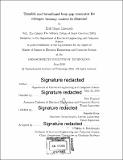Tunable and broadband loop gap resonator for nitrogen vacancy centers in diamond
Author(s)
Eisenach, Erik Roger
DownloadFull printable version (8.858Mb)
Other Contributors
Massachusetts Institute of Technology. Department of Electrical Engineering and Computer Science.
Advisor
Dirk Englund and Danielle Braje.
Terms of use
Metadata
Show full item recordAbstract
Nitrogen vacancy centers in diamond have emerged as a solid-state analog to atomic systems with applications ranging from room temperature quantum computing to quantum sensing and metrology. To date, with notably few exceptions, all NV applications rely on coherent manipulation of spin states via resonant microwave driving. In this thesis the loop gap resonator (LGR) is presented as a mechanism for the delivery of resonantly enhanced and uniform microwave fields to large volume samples of nitrogen vacancy (NV) centers in diamond. Specifically, an S-band tunable LGR and its constituent excitation circuitry are designed and fabricated to enable directionally uniform, strong, homogeneous, and broadband microwave (MW) driving of an NV ensemble over an area larger than 32 mm2 . The LGR design, based on the anode block of a cavity magnetron, demonstrates an average field amplitude of 5 gauss at 42 dBm of input power, and achieves a peak-to-peak field uniformity of 89.5% over an area of 32 mm2 and 97% over an area of 11 mm2 . The broad bandwidth of the LGR is capable of addressing all resonances of an NV ensemble for bias magnetic Fields up to 14 gauss. Furthermore, with cavity ring-down-times in the single nanoseconds, the resonator is compatible with the pulsed MW techniques necessary for a wide range of NV-diamond applications.
Description
Thesis: S.M., Massachusetts Institute of Technology, Department of Electrical Engineering and Computer Science, 2018. Cataloged from PDF version of thesis. Includes bibliographical references (pages 61-68).
Date issued
2018Department
Massachusetts Institute of Technology. Department of Electrical Engineering and Computer SciencePublisher
Massachusetts Institute of Technology
Keywords
Electrical Engineering and Computer Science.